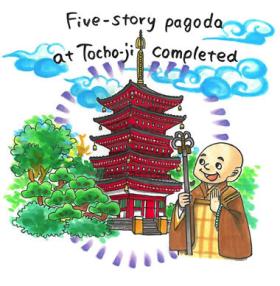Hakata Culture vol.53
The new five-story pagoda at Tocho-ji

When Kobo Daishi (Kukai) returned from T’ang Dynasty China in 809, he built Tocho-ji, said to be the first Shingon Mikkyo Buddhist temple in Japan. The temple has a long and distinguished history, and is the burial site for members of the Kuroda family, the daimyo of Fukuoka. The famous wooden statue of the seated Buddha, one of the largest in the nation at more than 10 meters high, has been designated an important national cultural treasure. A new five-story pagoda was built on the temple grounds this year to commemorate the temple’s 1200th anniversary.
The five-story pagoda is about 26 meters high, and was erected with traditional methods using cypress. The traditional construction methods for Buddhist temples or Shinto shrines employ no nails or other metal at all. The structures are built by cutting large grooves and rails in the wood and fitting the pieces together. This method is said to be noteworthy for its earthquake resistance. In addition, a structure was adopted that separates the central beams and the roofs of each story so as to better absorb the shock waves of an earthquake.
These traditional methods were likely developed because there are frequent earthquakes in Japan. Thanks to the skillfulness of our ancestors, there have always been many five-story pagodas throughout Japan. The oldest is said to be the one at Horyu-ji in Nara, which was built in the seventh or eighth century.
The structure of seismic isolation, which keeps the five-storied pagoda strong against earthquakes, has also been adopted for use in modern high-rises. The metallic upper portion of the pagodas is not as resilient, however, so that part of the Tocho-ji pagoda was rendered more quake-resistant by using a new construction method that involves coating the decorative section with a special rubber. That demonstrates the value of combining the traditional and the modern.
The interior of the pagoda contains a statue of the Buddha and beautiful Japanese-style paintings depicting the four seasons. It isn’t possible to see them other than on special occasions, unfortunately. But because Kyushu has few of these pagodas, it is worth it just to see the lovely wood structure itself. It will likely become a new Hakata tourist destination.
空海が開いた東長寺に五重塔が仲間入り
809年に中国・唐から帰国した弘法大師(空海)が、日本で最初に開いた真言密教の寺院と伝わる東長寺。福岡藩主・黒田家の墓があったり、国の重要文化財の仏像が安置されていたりと、とても由緒あるお寺です。高さ10m以上の日本最大級の木造坐像「福岡大仏」があることでも有名ですが、今年は寺の創建1200年を記念して境内に新しく五重塔が完成しました。
五重塔は高さ約26m、ヒノキを使った伝統的な木造工法で建てられています。寺社仏閣などに見られる日本の伝統建築では、釘などの金属類を一切使いません。木材に凸凹の切り込みを入れ、それを組み合わせることによって建物を造ります。実はこの工法、地震にとても強いのです。さらに五重塔では地震の揺れを吸収するよう、中心の柱と各階の屋根が離れた構造になっています。伝統工法は地震が多い日本ならではの工夫だったのでしょう。こうした先人たちの工夫のおかげで、地震が多いにも関わらず、今でも日本各地に古くからの五重塔がたくさん残されています。日本最古の五重塔は7~8世紀に建てられた奈良の法隆寺のものだそうです。
地震に強い五重塔の構造は、「免震構造」として現代の超高層建築にも取り入れられています。ただし五重塔最上部の金属の飾りだけは地震に弱かったのだとか。そこで、東長寺の五重塔には最新工法で特殊なゴムを装着して飾りの耐震性を高めました。まさに伝統と現代のコラボレーションといったところでしょうか。
塔の内部は仏像や四季の風物を描いた美しい日本画で飾られていますが、残念ながら普段は見学することができません。でも九州には五重塔があまりないので、木組みが美しい建物を見るだけでも価値あり。博多の新しい観光名所になりそうです。

